A mobile-friendly website is crucial in today’s digital landscape. Not only does it improve user experience, but it also helps your website rank higher in search results. Mobile searches make up more than half of all searches on Google, and if your website isn’t mobile-friendly, visitors are 5 times more likely to leave.
At WebsiteDesigner.Business, we specialize in web design that works seamlessly across all devices, ensuring your site looks perfect on any screen size. Partner with us to optimize your website for different screen sizes with responsive and adaptive design techniques.
Key Takeaways:
- Having a mobile-friendly website is crucial for improving user experience and search rankings.
- Mobile searches account for more than half of all searches on Google.
- A non-mobile-friendly website increases the likelihood of visitors leaving.
- WebsiteDesigner.Business specializes in web design that caters to all screen sizes with responsive and adaptive design techniques.
- Partnering with WebsiteDesigner.Business can ensure your website looks perfect on any device.
The Importance of Mobile-Friendly Websites
Having a mobile-friendly website is essential for several reasons. Firstly, mobile-friendly sites show up higher in search results, boosting your online visibility. Secondly, more than half of all searches are conducted on mobile devices, so it’s crucial to cater to this audience. Finally, if your site isn’t mobile-friendly, visitors are more likely to leave, resulting in missed opportunities. By optimizing your website for different screen sizes, you can ensure that all users have a positive experience, regardless of the device they’re using.
Enhanced Online Visibility
With the increasing number of mobile searches, search engines prioritize mobile-friendly websites in their rankings. By implementing web design for different screen sizes, you improve the chances of your website appearing on the first page of search results. This increased online visibility not only drives more organic traffic but also enhances your brand’s credibility and trustworthiness.
Catering to Mobile Users
As the majority of searches are conducted on mobile devices, it’s crucial to cater to this audience. Mobile-friendly website design ensures that users can easily navigate and interact with your site on their smartphones or tablets. By optimizing designs for multiple devices, you provide a seamless browsing experience, encouraging visitors to stay longer and explore your content.
Preventing Missed Opportunities
If your website is not mobile-friendly, visitors are more likely to abandon it and seek alternative options. Mobile users expect fast-loading pages, easy navigation, and intuitive user interfaces. If these expectations aren’t met, they will quickly move on to competitors’ mobile-friendly sites. By optimizing your website for different screen sizes, you ensure that you’re not losing potential customers or clients due to poor mobile experiences.

Responsive Web Design: The Key to Mobile Optimization
Responsive web design is a critical aspect of mobile optimization. It involves creating a website layout that flexibly adapts to different screen sizes, resolutions, and devices. With responsive design, elements of your website will scale appropriately to fit the screen, ensuring a seamless user experience.
By using CSS and stylesheets, your website can adjust to different size screens without compromising functionality or design aesthetics. Responsive web design is the industry standard for creating mobile-friendly websites that look great on any device.
Why is Responsive Web Design Important?
Responsive web design plays a significant role in ensuring that your website is accessible and user-friendly on all devices, regardless of screen size or resolution. With the increasing popularity of mobile browsing, it is essential to provide a seamless experience for mobile users.
“A mobile-friendly website is no longer a luxury, but a necessity in today’s digital landscape. By implementing responsive web design, you can cater to the growing number of mobile users and ensure that your website remains visually appealing and functional across all devices.”
With responsive design, your website will adapt to various screen sizes, whether it’s a small smartphone, a tablet, or a larger desktop monitor. This flexibility allows users to navigate your website easily without having to pinch and zoom or scroll excessively.
Additionally, responsive web design improves search engine optimization (SEO) by providing a consistent user experience across different devices. Search engines prioritize mobile-friendly websites, so having a responsive design can help boost your search rankings and increase your visibility online.
The Benefits of Responsive Web Design
Responsive web design offers numerous benefits for both users and website owners:
- Enhanced user experience: Responsive design ensures that your website looks and functions flawlessly on any device, improving user satisfaction and encouraging longer visit durations.
- Cost-effectiveness: Instead of creating separate designs for different devices, responsive design eliminates the need for multiple versions of your website, saving time and resources.
- Streamlined maintenance: With a single responsive design, making updates and changes to your website becomes more efficient since you only need to implement them once.
- Improved SEO: Responsive websites are favored by search engines, resulting in higher rankings and increased organic traffic.
Overall, responsive web design is essential for optimizing your website and providing a seamless user experience across all devices. By embracing this approach, you can ensure that your website remains accessible, engaging, and visually appealing to visitors, regardless of the device they use.
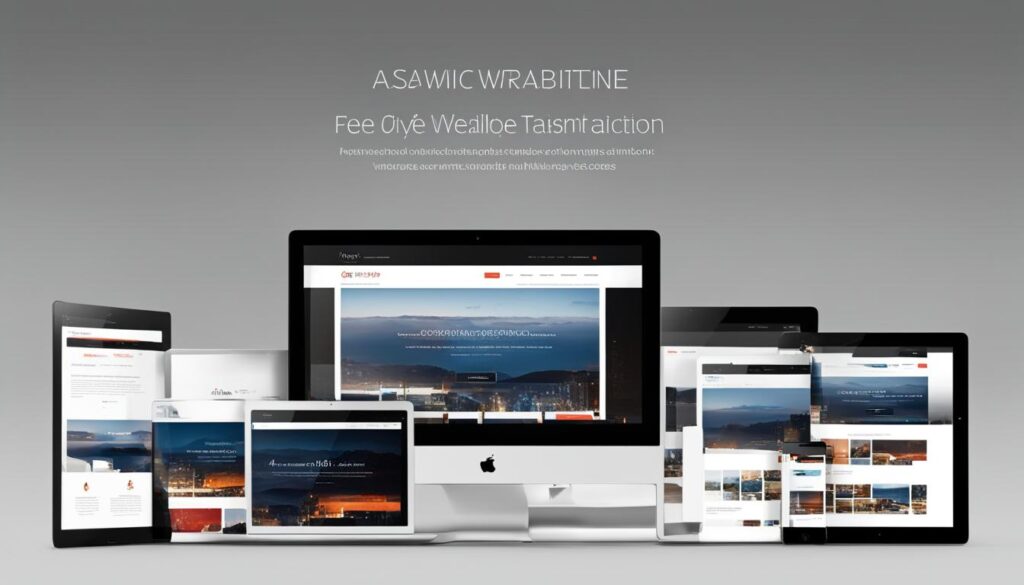
Designing for Various Resolutions: Best Practices
When designing for different screen sizes and resolutions, it’s crucial to follow best practices to ensure optimal results. Here are some key tips:
- Keep the design simple and clean: Avoid overcrowding the screen with too much content or complex layouts. Focus on a clean and minimalist design that is easy to navigate.
- Use responsive images: Optimize your images for the web and implement techniques like lazy loading to reduce load times on mobile devices.
- Prioritize mobile-friendly features: Make sure interactive elements like buttons, forms, and menus are touch-friendly and easily usable on smaller screens.
- Test across different devices: Regularly test your website across various devices to ensure a consistent and optimal user experience.
By following these best practices, you can create a mobile-friendly website that caters to users on different devices and resolutions while providing a seamless and enjoyable browsing experience.
Designing for Different Screen Sizes: Best Practices
When it comes to designing for different screen sizes, it’s important to follow best practices that ensure a seamless user experience across all devices. By optimizing your website for different device screen sizes, you can create a mobile-friendly design that attracts and engages visitors. Here are some essential guidelines to consider:
Create Fast-Loading Pages
In today’s fast-paced digital world, users expect websites to load quickly on any device. Slow-loading pages can lead to frustration and high bounce rates. To optimize screen size and deliver exceptional user experiences, focus on optimizing page load times. Compress images, minify CSS and JavaScript files, and leverage caching techniques to reduce loading times and keep users engaged.
Ensure Clear and Simple Navigation
Navigation plays a crucial role in helping users find information quickly and easily. When designing for different screen sizes, prioritize clear and intuitive navigation that is easy to locate and use. Simplify menus, use descriptive labels, and ensure that navigation elements are easily visible and accessible, even on smaller screens. By implementing simple and concise navigation, you enhance the user experience for all visitors.
Optimize Ease of Action
Allowing visitors to perform common tasks with minimal steps is essential for a mobile-friendly design. Whether it’s making a purchase, subscribing to a newsletter, or contacting your business, streamline the process to minimize friction. Simplify forms, utilize autofill capabilities, and provide clear calls-to-action that are easily clickable on all screen sizes. By optimizing ease of action, you encourage user engagement and drive conversions across devices.

Follow these best practices to ensure that your website is optimized for different device screen sizes. By prioritizing fast load times, clear navigation, and ease of action, you can create a mobile-friendly design that enhances user experience and drives success for your business.
Understanding Mobile-First Design
Mobile-first design is a design approach that prioritizes the mobile experience over the desktop experience. Instead of adapting a desktop design for mobile, we begin with designing for mobile devices and then expand to larger screens. With the majority of web traffic coming from mobile devices, it’s crucial to prioritize the mobile experience. By adopting a mobile-first mindset, we can ensure that your website is optimized for different screen sizes and provides a seamless user experience on all devices.
The Benefits of Mobile-First Design
- Improved User Experience: By focusing on mobile-first design, we create websites that are optimized for the smaller screens and touch interactions commonly found on mobile devices. This enhances the overall user experience, making it easier for visitors to navigate and interact with your site.
- Better Search Engine Rankings: Mobile-first design aligns with Google’s preference for mobile-friendly websites. By prioritizing the mobile experience, your website is more likely to rank higher in search engine results, increasing visibility and driving more organic traffic.
- Broader Reach: With the increasing use of smartphones and tablets, designing for mobile ensures that you reach a larger audience. By catering to the needs of mobile users, you can capture their attention and engage them effectively.
In today’s mobile-dominated world, a mobile-first design approach is essential to stay competitive. By putting mobile users at the forefront of our design process, we create websites that are not only visually appealing but also optimized for different screen sizes and devices. This ensures a seamless user experience and drives valuable results for your business.
Implementing mobile-first design involves several key principles:
- Simplicity: Simplify your website’s design and prioritize essential features. This allows for a clean and streamlined mobile experience, reducing clutter and optimizing functionality.
- Responsive Layout: Utilize responsive web design techniques to ensure that your website adapts seamlessly to various screen sizes. This flexibility is crucial in providing a consistent and user-friendly experience across devices.
- Touch-Friendly Interactions: Consider the unique interactions available on mobile devices, such as touch gestures and swiping. Optimize your website’s navigation and interactive elements to be intuitive and easy to use on touchscreens.
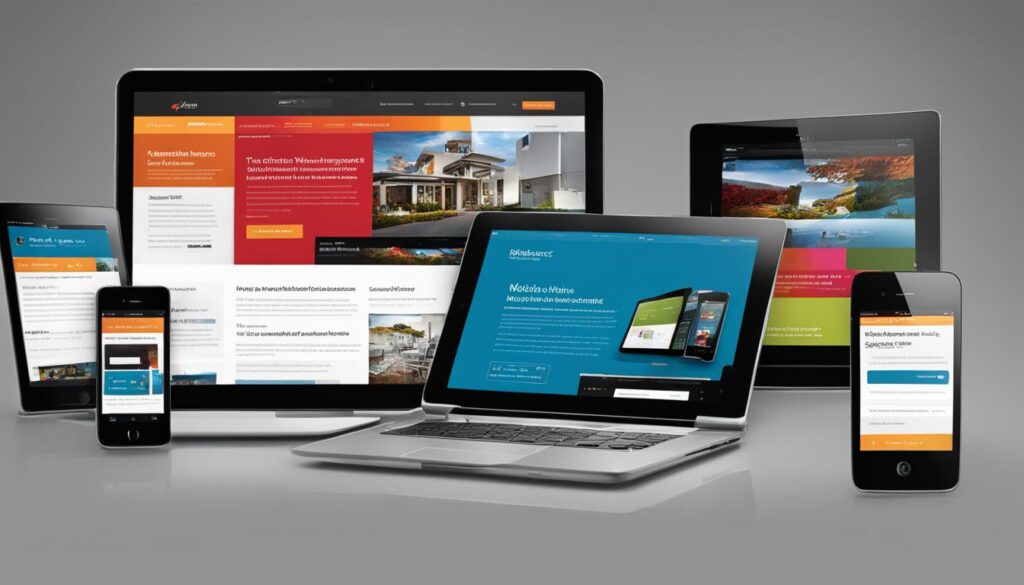
| Benefits of Mobile-First Design | Principles of Mobile-First Design |
|---|---|
| Improved user experience | Simplicity |
| Better search engine rankings | Responsive layout |
| Broader reach | Touch-friendly interactions |
The Power of Mobile Optimization
Mobile optimization goes beyond just having a responsive website design. It’s about creating a seamless user experience across all devices and optimizing your website’s content and functionality for mobile users. By considering the needs and preferences of mobile users, we can tailor our website to provide a user-friendly experience.
One important aspect of mobile optimization is optimizing page load times. Mobile users expect fast-loading websites, and delays can lead to frustration and increased bounce rates. By implementing techniques such as minifying code, compressing images, and caching content, we can ensure that our website loads quickly on mobile devices.
Simplifying navigation is another key factor in mobile optimization. Mobile screens are smaller, and users have less space to interact. By streamlining the menu options, minimizing the number of clicks required to access information, and incorporating clear and intuitive navigation elements, we can enhance the user experience on mobile devices.
Ensuring that all calls-to-action (CTAs) and forms are easy to use on smaller screens is crucial for mobile optimization. Mobile users want to easily perform actions such as making a purchase or submitting a contact form. By designing CTAs and forms with larger buttons, clear instructions, and minimal input requirements, we can maximize conversions and user satisfaction.
“Mobile optimization is about providing a seamless user experience across all devices and catering to the specific needs of mobile users.”
With mobile optimization, we can maximize engagement and conversions on all devices. By considering screen size optimization, creating a mobile-friendly design, and designing for different screen sizes, we ensure that our website is accessible and user-friendly for all visitors, regardless of the device they are using.
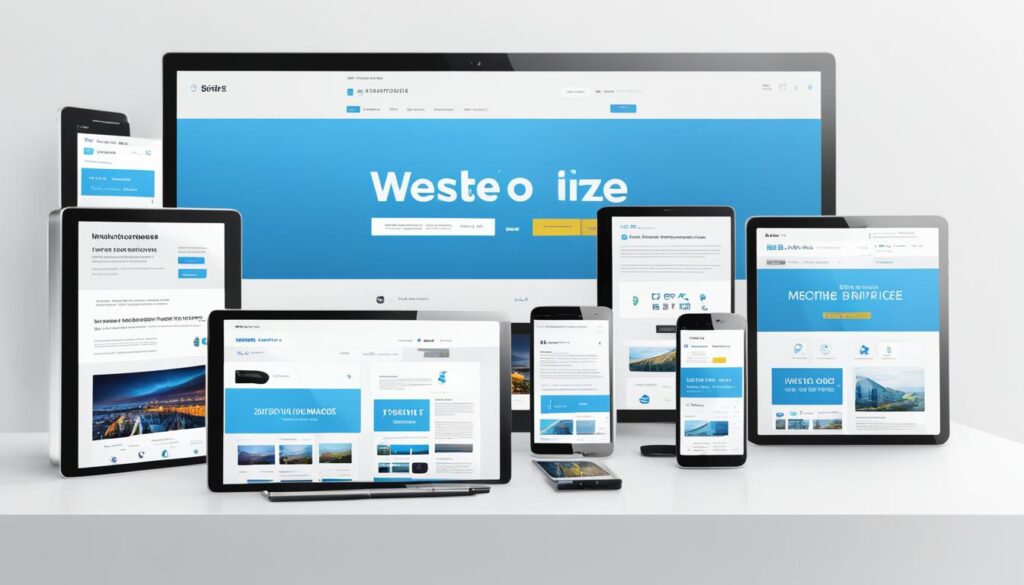
| Benefits of Mobile Optimization | Actions for Mobile Optimization |
|---|---|
| Improved user experience | Optimize page load times |
| Higher engagement and conversions | Simplify navigation |
| Higher search rankings | Make CTAs and forms mobile-friendly |
| Reduced bounce rates | Focus on responsive design |
| Broader reach to mobile users | Design for different screen sizes |
Mobile Optimization Checklist:
- Optimize page load times by minifying code, compressing images, and caching content.
- Simplify navigation by streamlining menu options and incorporating clear and intuitive navigation elements.
- Create mobile-friendly CTAs and forms with larger buttons, clear instructions, and minimal input requirements.
- Focus on responsive design to ensure that your website adapts seamlessly to different screen sizes.
- Design for different screen sizes by testing your website on various devices and adjusting layouts and font sizes accordingly.
By following these best practices and optimizing our website for mobile devices, we can provide a superior user experience and achieve better results in the mobile-dominated digital landscape.
The Journey to Mobile Optimization
The journey to mobile optimization starts by understanding your target audience and their behaviors on different devices. By analyzing data on how users interact with your website on mobile devices versus desktops, you can gain valuable insights into their preferences and pain points. This understanding will serve as a foundation for refining and improving your mobile experience.
Take the time to gather customer feedback and listen to their suggestions. This feedback can provide valuable insights into areas for improvement and help you identify specific pain points that users may be experiencing on mobile devices. By addressing these issues, you can enhance the mobile-friendliness of your website and create a better user experience.
Consider the rise of micro-moments in today’s fast-paced digital landscape. Users often turn to their mobile devices to fulfill specific needs or goals, such as finding information or making a purchase. By mapping out the customer journey and understanding these micro-moments, you can design a mobile-friendly experience that caters to your audience’s specific needs. This will help you create a seamless user experience and maximize engagement on mobile devices.
Benefits of Understanding the Customer Journey
“Understanding the customer journey allows you to identify touchpoints where your website can be optimized for mobile devices. By tailoring your design and content to meet the needs of mobile users, you can create a more engaging and satisfying experience.”
By investing in mobile optimization and designing for different screen sizes, you can ensure that your website delivers a seamless user experience across all devices. This not only enhances user satisfaction but also improves your website’s search visibility and conversions. At WebsiteDesigner.Business, we specialize in mobile-friendly website design and can help you navigate the journey to mobile optimization.
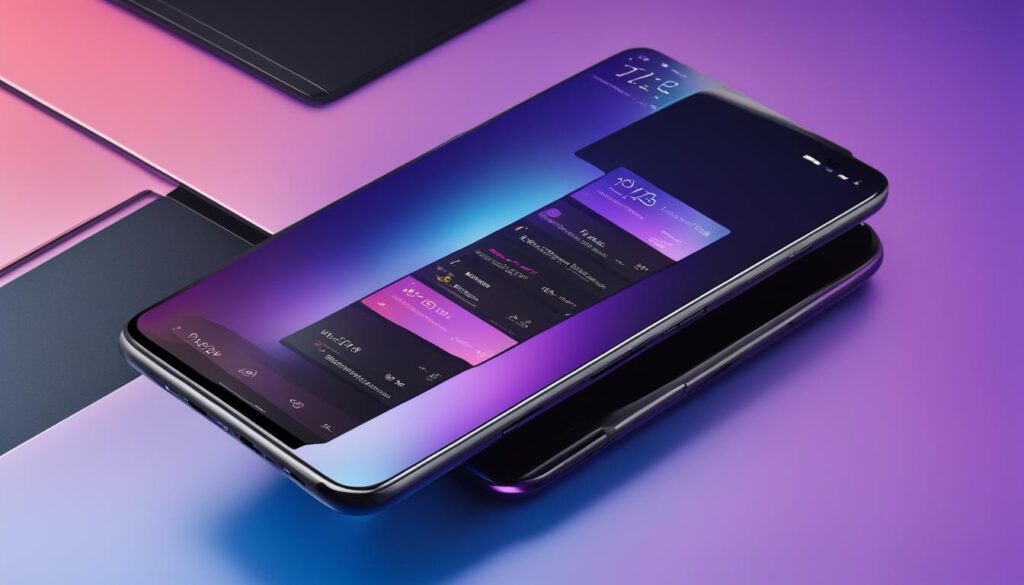
Partner with us to create a mobile-friendly website that is optimized for different screen sizes and offers a user-friendly experience on all devices. Order a plan on our website WebsiteDesigner.Business to get started.
Creating a Mobile-First Mindset
Adopting a mobile-first design and optimization approach is crucial in today’s mobile-centric world. We understand the significance of designing for different screen sizes and optimizing your website for mobile devices. By embracing a mobile-first mindset, you can enhance user engagement and drive better results for your business.
When it comes to mobile design and optimization, it’s important to consider how users interact with your website on mobile devices. Tailor your content and call-to-actions (CTAs) to meet their needs and expectations. Personalize the user experience by leveraging the unique capabilities of mobile devices. This can include features such as touch gestures, location-based functionality, and push notifications to create a more intimate connection with your audience.
“Designing with a mobile-first mindset allows us to prioritize the needs of mobile users and create a seamless user experience across all devices.”
With a mobile-first approach, you can ensure that your website is optimized for different screen sizes and provides a harmonious user experience on any device. Whether it’s a smartphone, tablet, or desktop, your website will adapt seamlessly to deliver a consistent brand experience.
By adopting mobile-first design and optimization techniques, you can:
- Create responsive and adaptive layouts that adjust dynamically to different screen sizes
- Optimize page load times to ensure quick and smooth performance on mobile devices
- Streamline navigation and make it intuitive for users on smaller screens
- Implement touch-friendly elements and gestures for improved usability
- Personalize content and CTAs to cater to the needs and preferences of mobile users
Success Story: XYZ Clothing
XYZ Clothing, a leading online fashion retailer, embraced a mobile-first mindset to enhance their digital presence. They recognized the growing importance of mobile optimization and designed their website with a focus on mobile users. By adopting a mobile-first design approach, XYZ Clothing achieved:
| Metrics | Before Mobile Optimization | After Mobile Optimization |
|---|---|---|
| Bounce Rate | 50% | 35% |
| Conversion Rate | 2% | 5% |
| Mobile Traffic | 30% | 60% |
By making mobile optimization a priority, XYZ Clothing significantly reduced their bounce rate and improved their conversion rate. They also witnessed a substantial increase in mobile traffic, allowing them to reach a larger audience and generate more sales.
Ready to embrace a mobile-first mindset and optimize your website for different screen sizes? Partner with us at WebsiteDesigner.Business and unlock the full potential of mobile optimization.

Optimizing Your Website for Mobile Devices
To ensure your website is optimized for mobile devices, follow these steps:
- Test your site using Google’s Mobile-Friendly tool for insights on its mobile performance.
- Implement responsive web design to ensure your site adapts to different screen sizes seamlessly.
- Streamline your site’s navigation for easy mobile browsing.
- Optimize load times to provide a smooth user experience.
By taking these steps, you can optimize your website for mobile devices and provide a user-friendly experience across all screens.
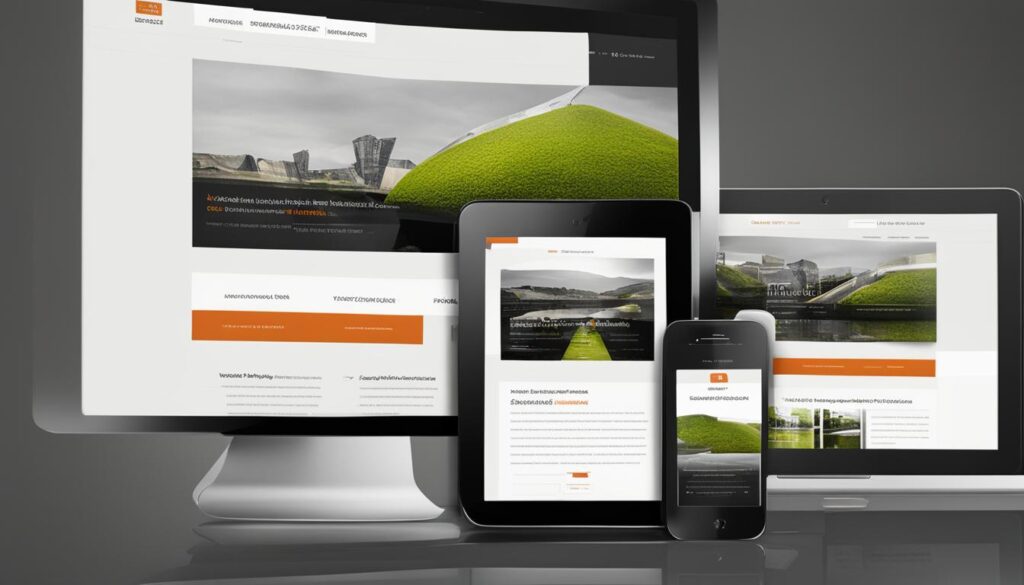
Considering the Metrics for Mobile Optimization
When it comes to mobile optimization, we understand the importance of measuring success using the right metrics. Traditional desktop-centric metrics may not accurately reflect the performance of your mobile website, so it’s crucial to adjust your measurement approach. By focusing on metrics that align with mobile user behavior, you can gain valuable insights and make data-driven decisions to continuously improve your mobile website’s performance.
Instead of solely relying on metrics designed for desktop experiences, concentrate on the following key metrics:
- Time on Site: Evaluate how long mobile users stay on your website. A longer time on site indicates higher engagement and a positive user experience.
- Engagement Rates: Measure the interaction and engagement levels of your mobile users, such as clicks, scrolls, and social shares. This metric helps assess the effectiveness of your design and content in capturing user interest.
- Conversion Rates Specific to Mobile Devices: Track the percentage of mobile visitors who convert into leads, subscribers, or customers. This metric reflects the mobile user experience, including the ease of navigation, clear call-to-actions, and mobile-friendly forms.
By analyzing these metrics, we can gain valuable insights into your mobile website’s performance and identify areas for improvement. Whether it’s enhancing the user interface, streamlining the mobile checkout process, or optimizing mobile-specific content, the data will guide our actions to increase mobile engagement and conversions.
At WebsiteDesigner.Business, we specialize in mobile-friendly website design and screen-responsive web development. We ensure that your website performs optimally on all devices, catering to the unique needs and preferences of mobile users. Let us help you leverage the right metrics for mobile optimization and take your online presence to new heights.
| Metric | Description |
|---|---|
| Time on Site | Measure the duration of mobile users’ visits. Longer time on site indicates higher engagement and a positive user experience. |
| Engagement Rates | Evaluate the level of interaction and engagement from mobile users, including clicks, scrolls, and social shares. |
| Conversion Rates Specific to Mobile Devices | Track the percentage of mobile visitors who convert into leads, subscribers, or customers. |

With these metrics in mind, you can make informed decisions to enhance your mobile website’s performance and meet the demands of your mobile audience. Trust WebsiteDesigner.Business to deliver mobile optimization strategies that drive results.
Conclusion
In conclusion, having a mobile-friendly website is crucial for businesses in today’s mobile-oriented world. Not only does it improve the user experience, but it also plays a significant role in improving search rankings and driving conversions. At WebsiteDesigner.Business, we understand the importance of web design for different screen sizes and mobile optimization. Our expert team specializes in creating mobile-friendly websites that provide a seamless user experience across all devices.
By adopting a mobile-first mindset, we prioritize the needs of mobile users, ensuring that your website looks perfect on any screen size. With responsive web design techniques, we create layouts that adjust and scale to different devices, maintaining functionality and design aesthetics. This optimization strategy not only improves user engagement but also boosts your website’s visibility in search results.
Don’t miss out on the countless opportunities that come with a mobile-friendly website. Take action today and optimize your website for all devices with our professional web design services. Visit our website WebsiteDesigner.Business to order a plan and take the first step toward staying ahead in the digital landscape.
FAQ
Why is having a mobile-friendly website important?
A mobile-friendly website is important because it improves user experience and helps your website rank higher in search results. With mobile searches making up more than half of all searches on Google, having a mobile-friendly website ensures that visitors are more likely to stay and engage with your site.
What is responsive web design?
Responsive web design is a design approach that allows a website to adapt to different screen sizes, resolutions, and devices. With responsive design, the elements of your website will scale appropriately to fit the screen, ensuring a seamless user experience on all devices.
What are some best practices for designing for different screen sizes?
When designing for different screen sizes, it’s important to focus on three key aspects: fast loading times, simple and clear navigation, and ease of action. By prioritizing these factors, you can ensure that users have a positive experience on your website, regardless of the device they’re using.
What is mobile-first design?
Mobile-first design is a design approach that prioritizes the mobile experience over the desktop experience. It starts with designing for mobile devices and then expands to larger screens. This approach recognizes the rise of mobile usage and ensures that your website is optimized for different screen sizes.
What is the difference between mobile-friendly design and mobile optimization?
Mobile-friendly design focuses on creating a website layout that works well on mobile devices. Mobile optimization goes beyond design and focuses on optimizing your website’s content and functionality for mobile users. It involves considering mobile user behavior, optimizing load times, simplifying navigation, and ensuring a user-friendly experience on smaller screens.
How can I optimize my website for mobile devices?
To optimize your website for mobile devices, you can start by using tools like Google’s Mobile-Friendly tool to identify areas for improvement. Implementing responsive web design, streamlining navigation, and optimizing load times are also important steps to create a user-friendly mobile experience.
What metrics should I use to measure mobile optimization?
Traditional desktop-centric metrics may not accurately reflect mobile performance. Instead, focus on metrics that align with mobile user behavior, such as time on site, engagement rates, and conversion rates specific to mobile devices. These metrics will provide insights into the effectiveness of your mobile optimization efforts.
How does mobile optimization benefit my business?
Mobile optimization benefits your business by enhancing user engagement, improving search rankings, and driving more conversions. With more people using mobile devices for their online activities, having a mobile-friendly website is crucial for staying ahead in the digital landscape.

Leave a Reply